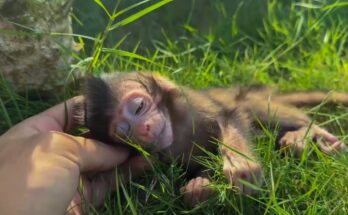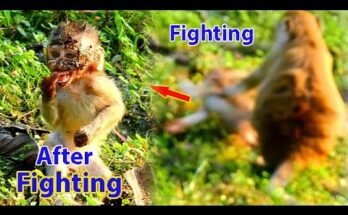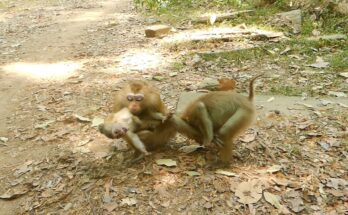The heart-wrenching scene of an innocent baby monkey crying after being hurt by a bigger monkey captures the fragile and often harsh reality of life in the wild. Baby monkeys, with their delicate bodies and tender emotions, depend heavily on the protection and care of their mothers or their troop. When a larger monkey causes harm to these vulnerable infants, it not only evokes a deep sense of sadness but also highlights the complex social dynamics within primate groups.
In the video or story behind this title, viewers witness a touching yet painful moment as the baby monkey, defenseless and confused, lets out loud, sorrowful cries. These cries express more than just physical pain; they reflect fear, distress, and the need for comfort. The innocence of the baby is evident in its trusting gaze and desperate attempts to seek help from nearby family members or its mother.
The bigger monkey’s actions might stem from various reasons common in primate behavior. Sometimes, dominant monkeys assert their authority or compete for resources, leading to aggression toward weaker members of the troop. Other times, the behavior might be a misguided form of discipline or a reaction to stress within the group. While these interactions are part of the natural social order, they are nonetheless heartbreaking when an innocent infant suffers.
This incident also serves as a powerful reminder of how vulnerable baby monkeys are in their early stages of life. Unlike human infants who rely on adult care in a relatively safe environment, baby monkeys face constant threats from within their own groups as well as from external predators. Their survival depends on quick learning, strong bonds with their caregivers, and sometimes sheer luck.
The emotional impact of seeing a baby monkey cry after being hurt is profound. It evokes empathy and compassion from the audience, reminding us of the importance of protecting wildlife and ensuring that these creatures have safe habitats where they can grow and thrive without undue stress or harm. It also raises awareness about the challenges that primates face in the wild, including social conflicts, habitat loss, and human interference.
Moreover, the situation highlights the significance of rescue and rehabilitation efforts by animal welfare organizations. Many baby monkeys who suffer injuries or are abandoned due to such conflicts require immediate medical attention and nurturing care to recover. Rescue centers often work tirelessly to provide these vulnerable infants with a second chance at life, nurturing them back to health and eventually releasing them into safer environments.
In conclusion, the sight of an innocent baby monkey crying after being hurt by a bigger monkey is a powerful, emotional scene that resonates deeply with viewers. It underscores the vulnerability of young animals in the wild and the sometimes harsh realities of their social worlds. Yet, it also serves as a call to action for greater compassion, protection, and support for wildlife conservation. By understanding these moments, we can appreciate the delicate balance of nature and the vital role humans play in safeguarding the lives of these gentle creatures.


